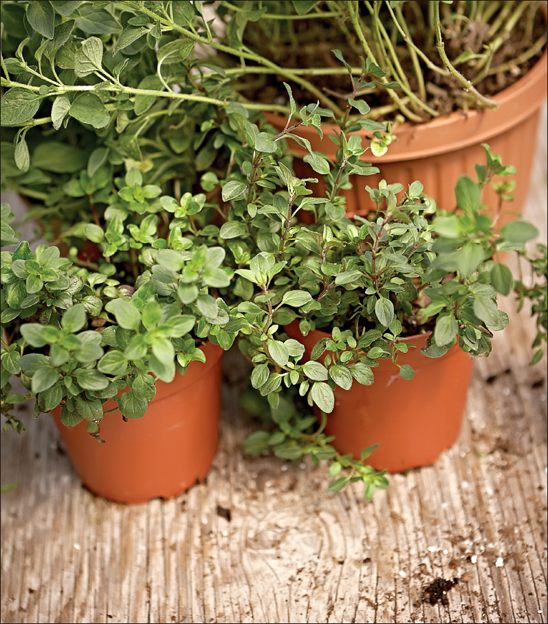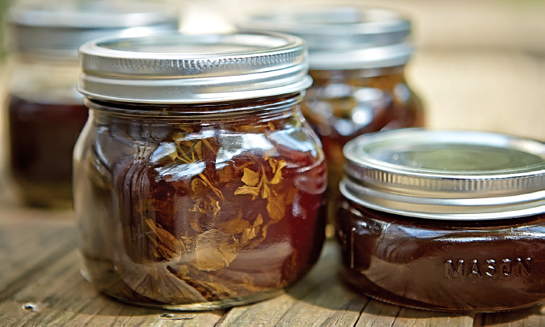
Oregano
The Greek root of the word oregano means “joy of the mountain.” Oregano has been bringing joy since ancient times with its sweet scent, warm flavour, and healing properties. Today, oregano is best known as an herb used in pasta sauce and pizza. It is a common seasoning used in cooking and also a preservative due to its very powerful antimicrobial qualities. In fact, that is how it is used medicinally.
 Health Benefits
Health Benefits
Traditionally, oregano was used to treat respiratory, gastrointestinal, and menstrual problems. Oil of oregano was also applied to the skin for the treatment of infection. Today, it is commonly used for oral and upper respiratory infections and gastrointestinal issues, including parasites.
The leaves, stems, and flowers of oregano all contain medicinal properties, the most important of which has been identified as the volatile oil carvacrol. It also contains thymol (the main ingredient in thyme). Together, these are potent antimicrobial oils, even at low doses. The research demonstrates that oregano has antiparasitic, antifungal, antioxidant, and antibacterial properties.
Oregano oil kills germs in three important places: in the gut, in the mouth, and on the skin. But be cautious: It isn’t intended for long-term use—it is very strong and can upset the essential friendly bacteria in your digestive system.
Bad bacteria in the gut are powerful. When they lurk in the grooves and crevasses of your intestines, they can be difficult for your immune cells to locate and destroy. But carvacrol helps break down the bad bacteria’s defenses, making it vulnerable to your immune army.

Oregano flowers. For a more productive plant, cut back before it reaches the blooming phase.
DIFFICULTY
Easy
HARDINESS
Annual (most varieties); Greek oregano is perennial in zones 5 and above
TIME TO PLANT
Spring
TIME TO HARVEST
Late spring through fall
LOCATION
Full sun
SOIL TYPE
Well-drained
Your mouth also contains a ton of bacteria. The good news is that carvacrol and thymol work as an antiseptic—indeed, thymol is the active ingredient in most brands of mouthwash.
Research reveals oregano oil’s antibiotic ability can help eliminate the bacteria that may be responsible for a skin condition called rosacea. And unlike a prescription antibiotic, oil of oregano will fight a yeast infection instead of causing one.
 Growing
Growing
Oregano is great for first-time gardeners. It’s easy to grow and a great addition to any herb or kitchen garden, especially if you enjoy pasta and tomato sauce! This herb can be both an annual and a perennial, depending on the variety. A word of warning: Oregano is often confused with marjoram, a closely related herb with similar leaves. However, marjoram has a much lighter flavour.
Common Varieties: Most cultivars are annual, including compact oregano (‘Compactum’) and golden oregano (‘Aureum’). I recommend Greek oregano (Origanum vulgare hirtum) for both its hardiness and its flavour.
PLANT
Oregano can be grown from seed or propagated from cuttings, and it can be transplanted easily. Sow seeds indoors 8 to 10 weeks before last frost date. When grown from cuttings, oregano will take about 4 to 6 weeks to root.
Transplants should be hardened off (see opposite) and then planted outdoors in a garden or container after the risk of frost. This plant’s number-one requirement is good drainage. Water moderately until roots are established, then only when dry during the growing season. Plant with air circulation in mind. Like most Mediterranean herbs, oregano grows best in full sun.
Starting seeds and cuttings indoors takes a little effort, but the feeling of growing your own is great! Before transplanting your seedlings outdoors, you need to get them adapted to light levels and temperatures. The process is called hardening off. It simply involves bringing seedlings outdoors on days when afternoon temperatures are over 15°C (59°F) and bringing them back in at night before the temperature drops. About 5 to 10 days of hardening off is recommended.
GROW
There is only one thing oregano hates: too much water! The main reason people fail at growing oregano is too much moisture, which causes root rot. Overwatering, high humidity, too much rain, and poor drainage can all lead to root rot and kill your oregano.
Oregano requires minimal fertilizer. When planted in the garden and amended with compost, it won’t need any fertilizer at all. I do, however, recommend fertilizing containers at least once every 4 weeks during the growing season. Use a compost tea or a 20-20-20 fertilizer.
This herb is a fast grower, and to ensure a good supply of tender leaves it needs regular haircuts. Even if you don’t need it, cut oregano back 10 to 15 cm (4 to 6 inches) as soon as you see flowers emerging. This will ensure healthy, fresh growth all season long. When cutting and/or pinching, remove one-third of the overall growth at a time.
Perennial varieties need to be kept in their place: Once a year, remove any section of oregano that has decided to “run.” Cut and divide with a spade, ideally on an overcast day to minimize shock to the plant.

HARVEST
Oregano grows quickly and can be harvested in early spring as soon as plants measure 20 cm (8 inches) high. I recommend harvesting just before the plant blooms, as you will find the flavour most intense. Harvest mid-morning or on overcast days when foliage is completely dry.
Frequent harvests are a must; the more you cut, the busier the plant will be! Just don’t cut the plant back more than 15 cm (6 inches) at a time.

Homemade oregano tincture (left). Homemade oregano oil is an inexpensive alternative to store-bought varieties.
STORE
Oregano can be used fresh or dried. Store fresh oregano wrapped in paper towel in the refrigerator for up to a week. To dry it, hang small bunches upside down out of direct light or use drying screens (see “Drying Herbs at Home” on page 365). Once dry, the leaves will be brittle. Store the leaves (discard stems) in airtight containers in a cool, dry place.
 Put It to Work
Put It to Work
Ready to use oregano? Start by making this potent oil!
The first step in unlocking the healing properties of oregano is extracting the oil. Start with 1 cup of fresh oregano leaves, washed and patted dry. Pour into a resealable glass jar (like a Mason jar) and top the jar with 1 cup of vodka (at least 80 proof). Place wax paper over the jar and then screw the lid on tightly to seal it. Set aside in a cool, dark place for 1 week.
After a week, using a coffee filter or cheesecloth, strain the oregano mixture into a clean jar. Cover it with a clean coffee filter or cloth and set aside in a dry, warm place for at least 7 days or until the alcohol completely evaporates. What remains is pure essential oregano oil. Store in an airtight container in a cool, dark place. The oil will keep indefinitely.
Pesky parasites? Pound them with this!
First, a warning: If you’re experiencing acute intestinal upset, don’t simply “suspect” you have parasites. Get confirmation from a knowledgeable healthcare practitioner. Testing stool for the presence of parasites and levels of beneficial flora, imbalanced flora, pathogenic bacteria, and yeast is the best way to start. This is an ideal approach for those with sudden changes in bowel pattern, and especially for those who have been travelling abroad or camping.
Once there has been a diagnosis, treatment often requires medications such as Flagyl, Humatin, or Yodoxin, but there is compelling evidence that oregano oil can be an effective part of your recovery plan. Even chronic issues may be remedied by oregano oil. For example, it may be effective against the common protozoan parasite Blastocystis hominis, which lives in the gut and has been associated with irritable bowel syndrome (IBS).
Add 10 drops of oregano oil to 1 teaspoon of olive oil. Take this 3 times daily before meals.
Because oregano oil inhibits growth of Lactobacillus (good bacteria) in the gut, a course of probiotics after use is a good idea.
Faced with rosacea? Apply this oil!
Rosacea is a skin condition that typically shows up like acne on the forehead, cheeks, nose, and chin. You’ll know if you’ve got it! It is slightly different from acne, since it presents as more of a flushing that turns into red pustules.
Excess sun exposure, alcohol, intense exercise, stress, spicy foods, and extreme hot or cold temperatures may trigger flare-ups. Often the issue is tied to “leaky gut syndrome,” whereby food sensitivities are the primary trigger. Oregano oil can help.
In a sterile glass jar with a tight-fitting lid, combine 2 tablespoons of almond oil with 1 teaspoon of oregano oil. Mix well. Dip a cotton ball into the mixture and dab on the affected area every night before bed so your skin has all night to absorb it. Store at room temperature.
Gum disease? Brush with this!
If your dentist has told you that you have deep pockets, periodontitis, or halitosis (bad breath), you are overgrowing bacteria in your mouth. Recent science shows this may lead to problems elsewhere in the body, including heart disease.
To limit your chances of gum disease, place 2 drops of oregano oil on your toothbrush, top with your favourite brand of toothpaste, and brush your teeth as you normally would for 2 minutes (30 seconds in each quadrant).



 Fast Forward
Fast Forward
Fast forward to the health food store to purchase North American Herb and Spice Oreganol or equivalent. Follow the instructions on the label.
 Cautions
Cautions
Do not take oregano oil orally longer than 2 weeks unless you have been advised to by your health practitioner! It can upset the good bacteria in your gut and create a probiotic imbalance. You should also avoid oregano oil if you are pregnant or nursing.
Be cautious if you have diabetes or low blood sugar, or if you take drugs, herbs, or supplements that affect blood sugar, as the glucosides found in the oregano leaf can lower blood sugar. Oregano may also slightly increase the risk of bleeding. If you have a bleeding disorder, take drugs that may increase the risk of bleeding, or are scheduled for surgery, avoid oregano oil.
Caution is also advised in patients with low blood pressure and in those taking drugs, herbs, or supplements that lower blood pressure. Oregano oil can cause a further decrease in blood pressure.